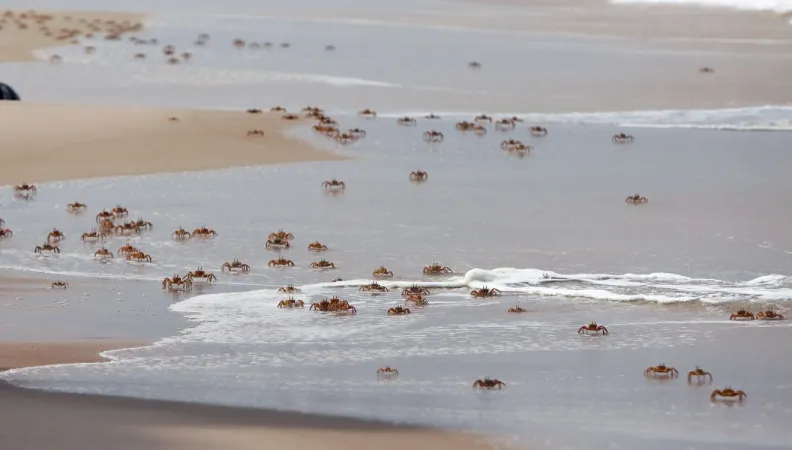Share the page
Assessment of Conservation Trust Funds: For the Benefit of Biodiversity
Published on

For the first time, a cross-cutting assessment of eight biodiversity conservation trust funds and their support by Agence française de développement (AFD) and the Fonds Français pour l’Environnement Mondial (French Fund for World Environment - FFEM) has been undertaken. Presented at the IUCN World Conservation Congress in Marseilles on 7 September, the study provides lessons on the implementation of these very specific financing instruments for biodiversity conservation.
Biodiversity conservation trust funds are both simple and essential: these financial institutions, which are independent of States, aim to ensure sustainable financing for biodiversity.
Further reading: France and AFD, Key Partners of IUCN
They collect resources from international donors, States or private sector stakeholders enabling them to generate, through diversified investments, a financial return paid back in the form of grants to protected areas or NGOs that act in favour of biodiversity conservation. These tools thus complement the support already provided by the States and the resources derived from tourism.
AFD and FFEM have been partners of these funds for nearly twenty years and complement each other in their efforts to innovate and develop tools and best practices to preserve biodiversity.
The eight funds assessed, located in Africa, the Mediterranean and Central America, have benefited, among other sources of financing, from contributions of nearly 70 million euros from AFD and the FFEM, with a strong focus on Africa and the Indian Ocean.
In partnership with other donors - notably KfW - the financing granted concerns the creation of new funds, but also support for their subsequent deployment. Between 2005 and 2019, these funds have paid out 58 million euros in grants to conservation stakeholders, protected areas and NGOs.
The originality of this assessment lies in an analysis at two levels: on the one hand, a comparative approach to the way the eight Conservation Trust Funds (CTFs) operate and, on the other, an assessment of the support methods used by the two donors (AFD and FFEM). Looking back over fourteen years of deployment, the scale of the study goes beyond French intervention alone in terms of its subject matter and geographical scope.
Compliance with standards of practice
The governance of the CTFs (internal functioning, representative of the stakeholders, procedures, operational guides) was assessed against the "standards of practice" developed by the Conservation Finance Alliance (CFA) which leads the Funds community and promotes the development of their expertise.
The assessment indicates general compliance, particularly by the Funds that have been in existence for a long time, and highlights a learning curve in the community, where the more recent ones benefit from the lessons and experience of the older ones.
Performance objectives achieved
The investment policies provide a framework for structuring the Funds' financial portfolio and define the return objectives, resulting from a risk/return trade-off.
An important lesson from the assessment is that these policies have been respected and applied in a successful manner, even during the financial crises of 2008 and 2020. The Funds have mostly achieved their financial performance objectives while limiting risk-taking.
Correcting funding imbalances
The assessment shows that CTFs, thanks to their stability and the flow of sustainable resources that they generate, help provide significant additional resources for the conservation of terrestrial, marine and coastal biodiversity. They complement public and private financing, project aid from donors and revenues from tourism, in a way that is unrelated to local conditions.
For example, in 2020-2021, these Trust Funds were able to continue to provide grants during the global health crisis, when much national biodiversity funding was cancelled.. Managers of protected areas recognise Conservation Trust Funds as a valuable source of funding for their operations.
A proven catalyst
The international community is committed to increasing the surface area to be conserved and the number of marine and terrestrial protected areas everywhere and, in these contexts, to taking better account of the needs of the populations living in the vicinity and of the climatic challenges. The result is a sharp increase in the funding needed and the areas to be covered.
For the trust funds, this translates into new activities, issues around growth and diversification of funding sources and also increased requirements in terms of monitoring activities. The assessment highlighted the capacity of some funds to dynamically mobilise new resources and noted an active role as a catalyst for the development and mobilisation of innovative financing tools (such as payments for environmental services, ecological compensation, etc.).
Ethics and impact: two challenges ahead
However, the assessment work reveals limitations in the monitoring of ethical standards applied to the investments, particularly in view of their composite nature. They highlight the challenges concerning strengthening ethical ambitions, their formulation and effective implementation. Discussions are taking place to improve the control with increasing recourse to so-called socially responsible investments that respect environmental, social and governance criteria.
The analysis was also intended to assess the impact on the ground of the financing granted by these funds and, more specifically, their effective contribution to biodiversity conservation. While efforts are being made to take better account of environmental and social risks and gender in the definition and monitoring of the activities, it appears that the impacts are not easily measurable and attributable to CTF support, even when some have developed harmonised monitoring tools.
This means that the challenge of monitoring the impacts remains a major one. The assessment recommends that the CTFs encourage beneficiary protected areas to develop more appropriate tools themselves to measure their management performance and better characterize conservation results at the habitat and species level, while taking social aspects more into account.
The assessment confirmed the usefulness and resilience of the conservation trust funds. The challenges identified in terms of investment sustainability and transparency need to be addressed if the Funds are to take the next step in their development. Scaling up will require diversification of the funding sources and mechanisms.
"Trust funds have proven their effectiveness as sustainable financing mechanisms for conservation. However, the challenges facing biodiversity require an ambitious change of scale, confirms Thierry Renaud, Impact and Sustainability director at the Mava foundation. The recommendations of the assessment are global in scope and will enable all stakeholders to accompany this transition. In this respect, the collaboration between the MAVA Foundation, AFD and the FFEM, particularly in supporting innovation and organizational strengthening, is exemplary”.
